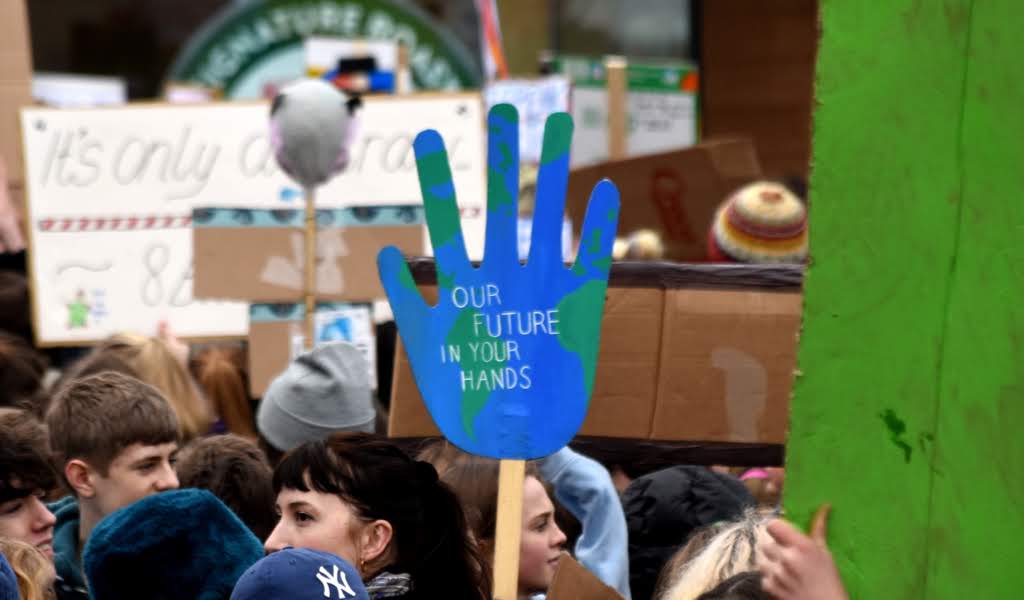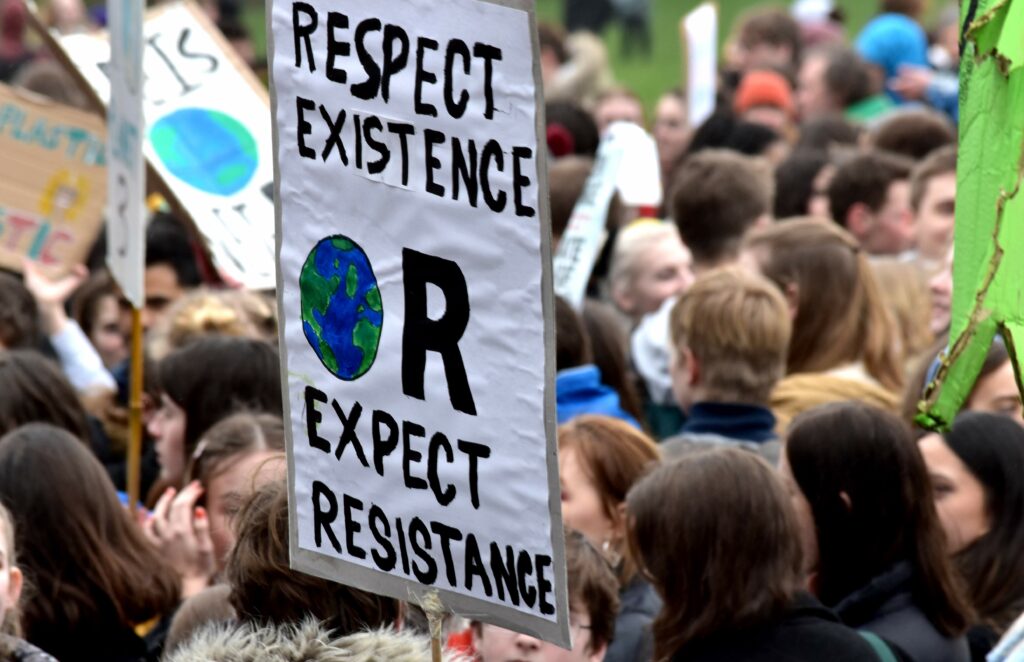
A global youth movement to force government action on climate change has brought 1.4 million children and young people out on strike and created a dilemma for parents, teachers and politicians alike. The #FridaysforFuture protests began in Sweden in the hot summer of 2018 as a one-person protest by an unassuming 15-year old called Greta Thunberg.
In less than a year her solo action resulted in days of action seeing more than one million young people demonstrating. Their protests have dominated global media headlines, returned climate change to the centre of public attention and steered debate toward exposing the complacency and inaction of governments.
She questioned why she should attend school and listen to teachers when politicians don’t listen to the facts. She intended to sit outside parliament until the politicians took action.

The teenager’s timing was well chosen. The Swedish elections were due in September 2018 and her country was experiencing record heat waves and wildfires in the hottest summer since Swedish records began 262 years ago. Her first day she sat alone, the second day others joined in, and after a few weeks, her quiet protest had captured the imagination of the media. By October, 8 girls in Victoria, Australia, decided to organise a demonstration on the other side of the world and, by November, participants numbered in their thousands.
Children in other cities across the world took to the streets to demonstrate their support – usually starting with a handful but building quickly to hundreds and even thousands. Today Greta has 351K followers on Twitter and leads a social movement of millions. She still refuses to return to school until Swedish policies provide a safe pathway to achieving temperature rises well under 2-degrees C, as laid out in the Paris agreement.
The summer of 2018 was a catalyst for change in other places too: in the US, the Sunrise Movement launched Sunrise Semester – employing 75 full-time youth organizers across 5 key states to “build their power and mobilize their communities”. They aim to hold fossil fuel executives and politicians accountable, and only elect politicians who commit to action on climate change. Other new or still active groups include UK Student Climate Network and Youth Climate Coalition. These movements are making huge efforts to coordinate efforts globally, although the US group is specifically organised and affiliated with the Democratic Party’s Green New Deal.
On the most recent protest day, Friday 15 March 2019, children walked out of schools in 2,233 cities and towns in 128 countries, from Australia to India, the UK and the US, according to the Fridays for the Future initiative.
The numbers read as a force to be reckoned with:

The issue of students striking has been criticised as truancy and unhelpful by some in government and the educational establishment, but this remarkable young woman has spoken at the UN, given a TED talk, appeared at the elite Davos summit and has just been nominated for the Nobel Peace Prize. She looks unlikely to go away having inspired not just her peers but older advocates for climate action.
The example of the Youth strikes 4 climate is interesting because it demonstrates that a younger generation, sometimes dismissed as disinterested or self-absorbed, care passionately about our collective survival. Most people feel the issue is too large and beyond their control. Through intelligent analysis, personal bravery and sheer stubbornness, she has shown that action yields results. She has raised the profile of climate change in a way that no one else has come close to achieving in recent years and galvanised others to action.

The movement is also unusual in that it is led by young people and has been adamant that – although they encourage adults to join and show support – they must not take over. She uses the advice of adults to ensure her message is accurate, but she writes her own speeches and doesn’t mince her words. This uncompromising, hard-hitting tone is particularly effective coming from a child.
The fact that Greta has been diagnosed with Asperger’s Syndrome and elective mutism adds an additional element. Asperger’s has been brought into the public eye through TV shows more recently in the UK, but is still under diagnosed in girls. Greta speaks of it as a “gift” and describes how her inability to be with others is what led to her lone protest. Her condition is therefore part of the phenomenon too. Her different view of the world means she holds herself to very high standards and expects the same from others – she is not interested in excuses and doesn’t attempt to please or be liked.
A child can perhaps make the future a tangible concern for adults in ways that little else can, in the context of systems that plan only a few years ahead. In a devastatingly direct blog, she compared us to the Titanic heading for the iceberg but with the full knowledge that the iceberg is there:
“Will we slow down in time?
If I live to be 100 I will be alive in the year 2103.
When you think about “the future” today, you don’t think beyond the year 2050. By then I will, in the best case, not even have lived half my life. What happens next?
The year 2078 I will celebrate my 75th anniversary. If I have children and grandchildren they may want to celebrate that day with me. Maybe I will tell them about you? How do you want to be remembered?”
Despite being so young, Greta Thunberg understands the complexity of the issue we face and is identifying that the answer is probably in greater transformation than most politicians are willing to face. She wrote:
“People keep asking me ‘What is the solution to the climate crisis?’. They expect me to know the answer. That is beyond absurd, as there are no ‘solutions’ within our current systems.”
“We need a whole new way of thinking. The political system that you [adults] have created is all about competition. You cheat when you can because all that matters is to win. That must come to an end. We need to start cooperating and sharing the remaining resources of this planet in a fair way. We are just passing on the words of the science. Our only demand is that you start listening to it, and then start acting.”
There is an inherent danger of any movement focusing too much on one person as a single hero. This must be amplified if the person is a child. Yet Greta Thunberg seems remarkably focused and steady. The media will of course constantly be looking for new stories, new people, or any chink in her armour.
The issue now is whether the will of so many young people can translate into economic or political transformation.
The young people’s climate strike action is set against a background of organisational inaction and endless prevarication by adults. Globally agreed targets have been set for reducing carbon emissions to prevent climate change reaching a point of no return; yet there appears no sense of urgency – immediate issues such as Brexit in the UK, trade deals in the US, and economic growth in China still prevail.

In the West, the last few years have seen a rise of commentary on generational divides – the feeling that those born in the 1940s and 1950s have benefitted hugely from rising living standards and property value hikes, leaving younger people behind. There is much talk of how this generation will be the first to be poorer than their parents. Older people have eaten all the pies and are leaving the washing up for their children. Or perhaps more graphically, as Greta Thunberg put it: “I am doing this because you adults are shitting on my future.”
We have seen this generation assert its voice already: on gun control in the US after shootings in Parkland , Florida, – they use school walkouts too and are said to have given Greta the idea; throughout the Arab Spring; the Occupy movement against corporate globalisation; in Iran, where lone young women waved white scarves in protest against being forced to wear the hijab; and globally by the remarkable teenage Nobel laureate Malala Yousafzai, who was shot by the Taliban for blogging about girls’ education, but refused to be cowed. Other less well known individuals have led initiatives against child labour in India.
There are also other young people working with Our Children’s Trust to protest against climate change but via the US legal system although the extent to which it is led by young people in unclear. They are suing the federal government and several state governments for failing to address the consequences of climate change. US law indicates that the government holds resources such as land, water or fisheries as treasure for the people. The children’s lawsuits extend that principle by asserting the government also is a trustee of the atmosphere. So far, the cases have been lost or are on appeal.
The school strikes for climate change have happened so rapidly because of effective communication – a direct message with a different tone that carries a long way. Greta Thunberg has maintained control of her messaging and taken great care to get her facts right. She speaks directly to people, using her mobile phone to film herself.
It also helped that she was invited to speak to the EU parliament, to the UN secretary general, at Davos to the World Economic Forum and at TED. These outlets for her message enabled it to spread quickly throughout the global media, business and policymaking world. However, its penetration to mass culture may be less than we think – in the UK, the Guardian and the BBC have featured her work, and CNN in the US, but many outlets give it little more than a mention. Some rightwing press coverage has been critical of those who encourage children to skip school, saying they are not really informed.
The fact that most children and young people are gathered together each day in a single place also means that they are practically available for action in a way that adults, dispersed throughout a range of locations and activities in their working day, are not. The simple idea of a strike from school is appealing to students, easy to organise because they are together daily, and memorable.
The energy of young people taking to the streets has also fed into the wider climate grassroots movement such as Extinction Rebellion and Climate Emergency, rejuvenating the environmental movement.
Youth is a beacon with its own unique light, but it also has a built in problem – time is not on its side. Children grown up, young people take on responsibilities and become sidetracked, leaving governments to heave a sigh of relief and go back to business as usual. Institutional foot-dragging tries the patience of everyone – so how can a teenager be expected to sidestep this or sit it out? Will this movement be able to develop a foundation for the consistent, ongoing pressure against the inertia of the adult world and the intransigence and power of the establishment?